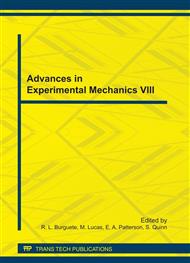p.213
p.219
p.225
p.231
p.237
p.243
p.249
p.255
p.261
Analysis of the High Strain-Rate Behaviour of Polyethylene Based Nanocomposites
Abstract:
Advanced polymeric materials and polymer based nanocomposites are finding an increasing range of industrial and defence applications. These materials have the potential to improve combat survivability, whilst reducing cost and weight. This study deals with nanocomposites manufactured from blends of low density polyethylene (LDPE) with various nanofillers. The high strain rate behaviour of these materials was investigated using the split Hopkinson pressure bar (SHPB) test. The experimental results for non-reinforced materials were used as a reference to analyse the effect of the nanofillers on the properties and performance of the nanocomposites. These results, together with those obtained from other mechanical tests, will be used as input into finite-element analyses to simulate the performance of these materials in lightweight armour applications. In the first step, the finite element model was validated by simulating the SHPB test and comparing the predicted results with those from the experiments. Explicit finite element analysis was used for the simulation. The fully developed model was able to demonstrate the behaviour of the test bar and specimen interaction correctly and reasonably good agreement between predicted and experimental results was observed.
Info:
Periodical:
Pages:
237-242
Citation:
Online since:
August 2011
Price:
Сopyright:
© 2011 Trans Tech Publications Ltd. All Rights Reserved
Share:
Citation:


